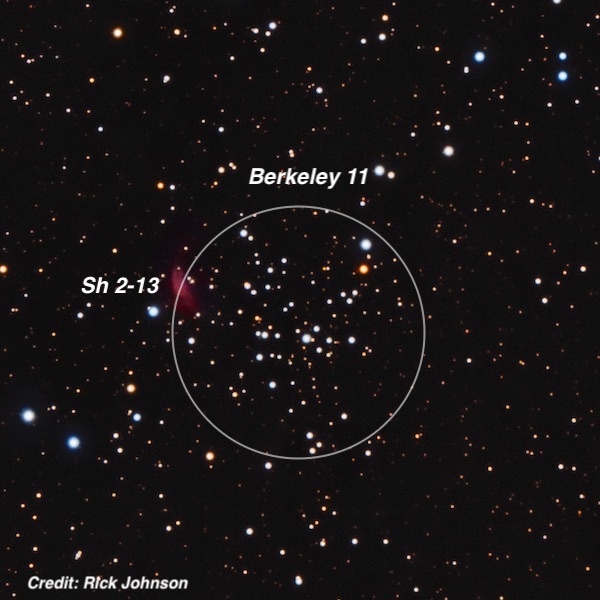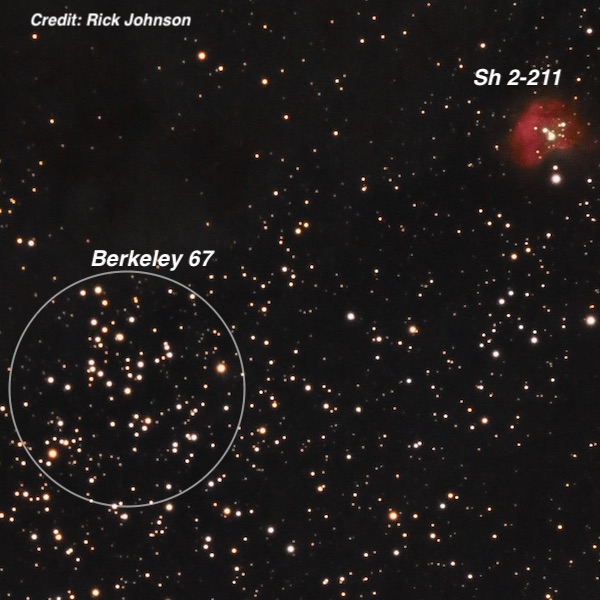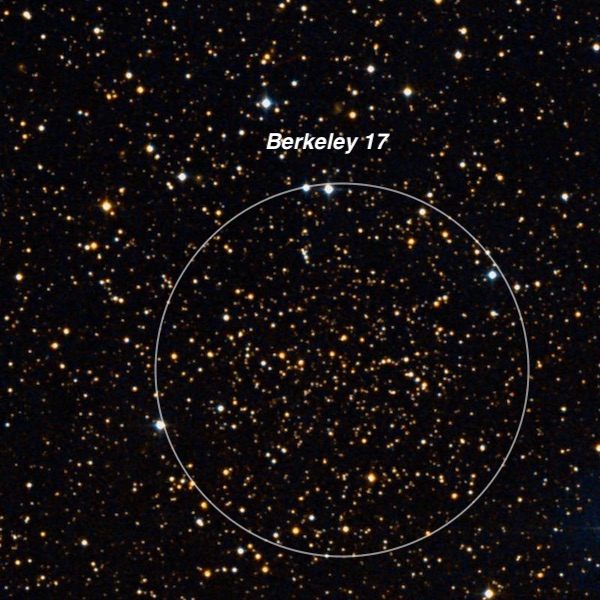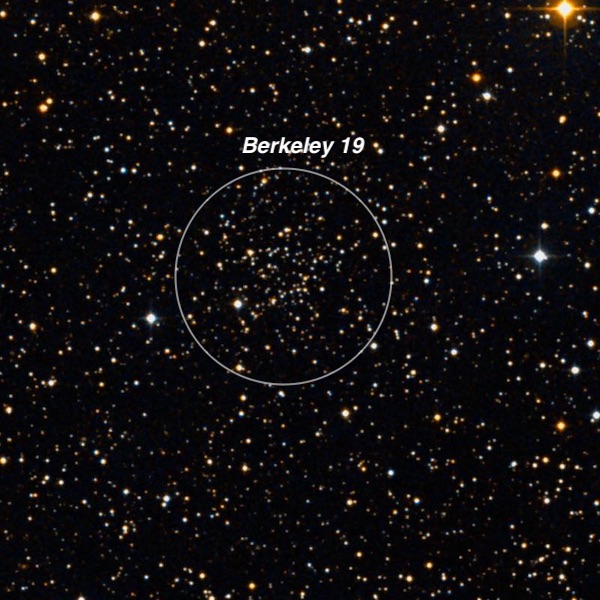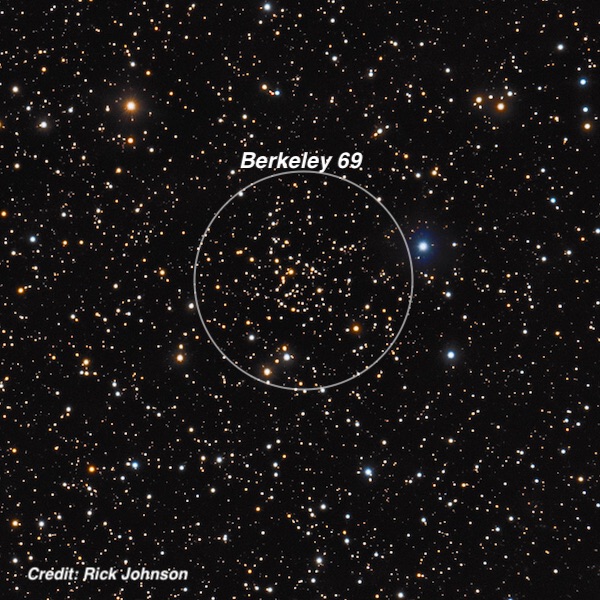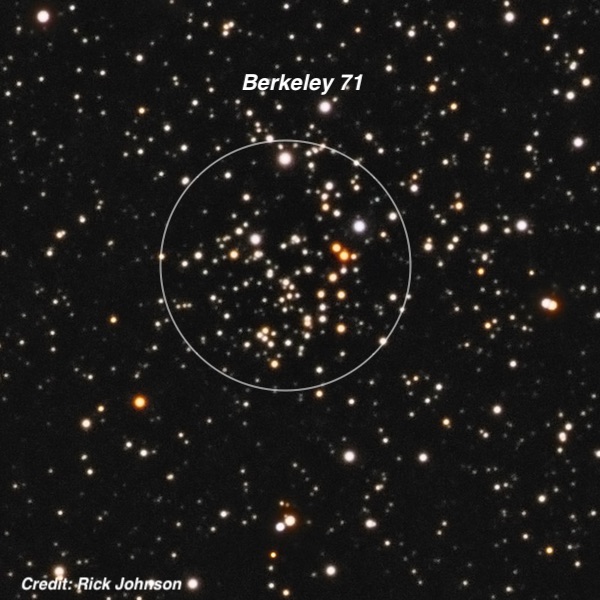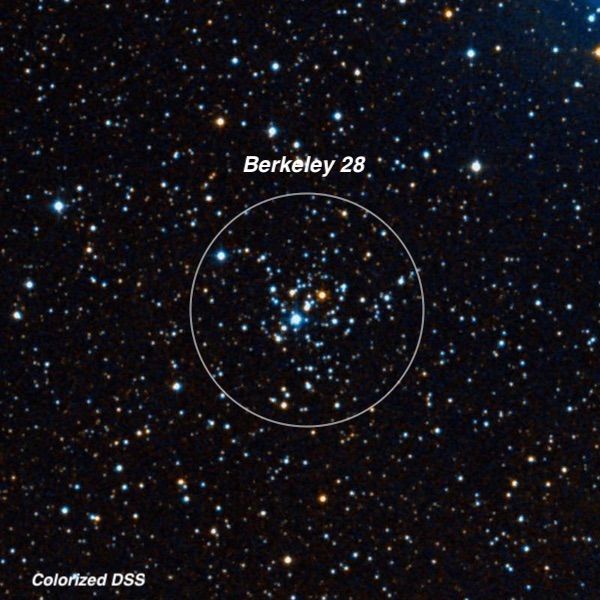OR: Go Bears! The Berkeley Open Clustersr
|
It was the 1960’s in Berkeley (well 1962, anyways)
and two radio astronomers, Arthur Setteducati and Harold Weaver (the
latter passed away in Kensington two years ago at 99), published a two-part
paper/atlas titled “Newly Found Star Clusters”. These are
104 open clusters discovered on the Palomar Observatory Sky Survey and
which now carry the designations Berkeley 1 through Berkeley 104. As
you might guess, since they were missed in the surveys by the Herschels
and others, the Berkeley clusters tend to be faint — which generally
translates into distant, obscured or ancient.
Both last week (Tue. Feb 18) and this past Monday (Feb 24) I observed at Lake Sonoma with Carter Scholz and Jim Molinari the first night and Bob Douglas and Dan Smiley joined Carter, Jim and I on the 24th. The weather forecasts for the 18th were wildly divergent, with the NWS predicting clear skies and the Canadian Meteorological Center (CSC) showing mostly cloudy. Carter and I decided to be optimistic and took a chance, particularly as we've had no decent observing since November and we had already passed on one opportunity in December that may have turned out fine. We ended up with mixed weather conditions, but mostly pretty good to very good, particularly at the end of the night. There was a 1+ hour stretch with thin clouds and poor transparency in much of the sky, but later on my SQM meter hit 21.45 consistently On the 24th, it was perfectly clear all night, no dew, dark with good transparency. In fact, my meter reached 21.50-21.55 mag/Sq. arcmin overhead, which is shockingly good. The one downside was mediocre seeing, which limited my magnification to about 260x. As a result, I probably didn’t reach as deep of a magnitude limit with the Berkeley clusters. On both nights I took a look at comet C/2017 T2 (PanSTARRS), a mag 8.5-9 comet, which was pretty bright, but not really a showpiece. Also on the 24th, I observed the type Ia Supernova 2020ue in NGC 4636. This one was discovered on January 12th, 45” west and 102” south of the nucleus, so is about 6 weeks old. It’s still hanging in there about 14th mag (though dropping in brightness) and was very easy to see as it’s not near the core. Over the two nights I logged 90 objects, with 70 of these galaxies.
An unusual object (not a galaxy) was the red star G 77-61, a 14th
magnitude dwarf carbon star in Taurus at 03 32 38.1 +01 58 00. Although
popular carbon stars like R Leporis (Hind's Crimson Star) are red
giants, dwarf carbon stars are apparently the largest number with
around 1200 candidates known to date. It’s not known whether
they possess primordial carbon-enhancements, or are polluted by mass
transfer from an evolved companion but the binary mass transfer seems
the most likely hypothesis. Besides the many galaxies, I tracked down
a number of the Berkeley clusters, which lie in Auriga, Perseus and
Canis Major. So, these are dedicated to my alma mater. Steve Gottlieb
Berkeley 11 Berkeley 11 is a relatively young open cluster (age ~50 million years) in Perseus, at a distance of ~9400 light years. The cluster is reddened by dust by nearly 1.0 magnitude, even though most of the brighter stars look blue-white in this image. The red emission nebula Sh 2-213 is just off the east side, but I didn't try a filter to see if it was visible (this image used an H-alpha filter to capture the nebula). Perhaps Mark has tried for it when he on a Sharpless quest. At 260x it was a very obvious group of ~30 stars in a 5' field with a mag 10 star (non-member) at the northwest corner. A number of stars are arranged in two elongated groups or strings, giving the cluster a wedge shape tapering and pointing to the south. A trio of stars marks the south tip of the cluster. There was some unresolved background haze from dimmer unseen members with the resolved stars in the mag 13-15 range. About 6’ east-southeast is a 1' pair of mag 9/9.5 stars.
Berkeley 67 Berkeley 67 is also in Perseus and is also close to an emission nebula, namely Sh 2-211. This image also suggests there is a lot of nearby dust, as the region just north (above) the cluster looks like a black thumbprint. Two studies came up with distances of 5400 and 8000 light years. Take your pick. The one age study reported it at ~1 billion years old. Happy birthday. This cluster is also reddened by 0.8 magnitudes. I observed this cluster at both 260x and 375x and found 15-20 faint stars that sparkled over a background glow ~5' in diameter. The resolved stars are mainly on the north side of the cluster and appeared pretty uniform in brightness, probably in the 14.5-15.5 magnitude range.
Berkeley 17 Berkeley 17 is one of the oldest known open clusters (NGC 6791 is comparable) in the Milky Way with an age of 8.5-10 billion years! A 2004 study reported an even 10 billion years, which is comparable to the ages of relatively metal-rich inner halo globular clusters! Berkeley 17 is located at a low Galactic latitude (not far off from the plane of the Milky Way in the direction of the Galactic anticenter). Due to the location and large distance (8800 light years) the field is highly reddened and contaminated by closer field stars. At 200x, I immediately noticed a very large though faintish glow, perhaps 8' diameter. Two mag 11.5/12.5 stars (non-cluster members) are at the north edge, a mag 11 star is at the east edge and a string of mag 12-15 stars oriented SW-NE are along the NW border. A 3' group of mostly mag 14-15 stars marks the SE edge of the cluster. In addition, several 15th magnitude stars glimmered in the interior of the cluster.
Berkeley 19 Berkeley 19 is a pretty dim cluster, despite the somewhat misleading total magnitude of V = 11.4. A 2004 study reported an age of ~2.5 billion years, so this one is no spring chicken either. At 200x I found a very low surface brightness, hazy patch, perhaps 2’ in diameter. It is situated immediately west of a mag 12.3 star and is collinear with this star and a mag 11.5 star 2' further east (one inside/one outside the circle in this image). Only a few 15th magnitude stars were resolved. NGC 1896, a scattered asterism, lies 25' SE.
Berkeley 69 Berkeley 69 is a moderately old cluster with an age of ~900 million years. It lies in southwestern Auriga (about 1° from IC 410, a photogenic cluster/emission nebula) at a distance of 9300 to 13000 light years, depending on the source. The cluster is lacking in bright, massive, blue O and B stars which have died out due to age, and the cluster is reddened by 0.65 magnitudes due to dust, giving the stars a reddish hue. Using 260x, a glowing circular patch ~2’ diameter was evident with only 4 or 5 stars resolved. At 375x, roughly a dozen stars were resolved, mostly forming a circular ring that was open on the west side except for a single star. The two brightest 13th magnitude stars are on the NE and W side of the ring. The bright blue star to the right of the cluster is 8.3-magnitude HD 35132 and is not part of the cluster.
Berkeley 71 Berkeley 71 lies in Auriga, only 1.2° southwest of M36. It’s a pretty distant cluster at 3.26 kiloparsecs (~11,000 light-years) with an age between 600,000 and 1 million years. Milky Way dust reddens the stars by 0.9 magnitude. Visually it was fainter than this image suggests. I recorded it as "faint, moderately large, roundish, irregular surface brightness with signs of resolution and a few obvious stars around the edges, as well as a 12th magnitude star 2' N of center. At 375x, it resolved much better with a number of mag 15+ stars popping on and off, at least a dozen stars total in the central region.
Berkeley 28 = Biurakan 10
At 260x about a dozen stars were resolved in the central region, including a half-dozen in a NW-SE string that passes through the center. Three stars at the northeast corner (mag 11.7), northwest corner (mag 13.4) and south vertex (mag 13.3) strengthen an impression the cluster is triangular. Perhaps two dozen stars total were resolved within this outline. This cluster is found 10' southeast of mag 6.4 HD 50062. I had previously viewed it in my 18” Starmaster (now deceased) and I was surprised how similar my notes sounded.
|
